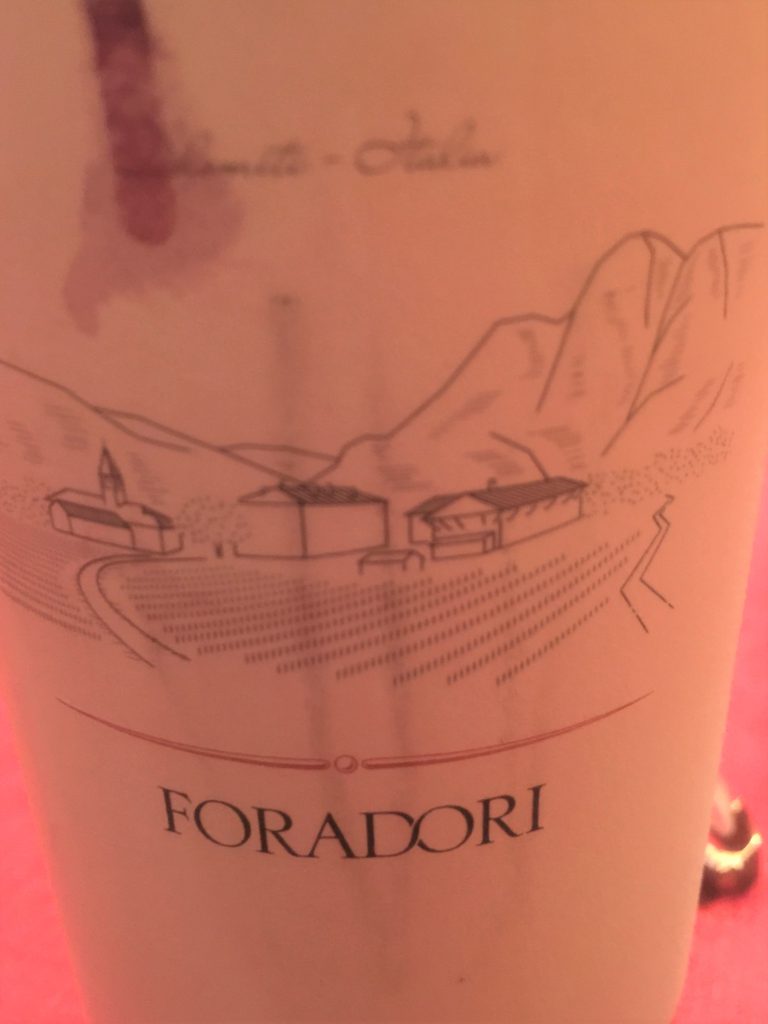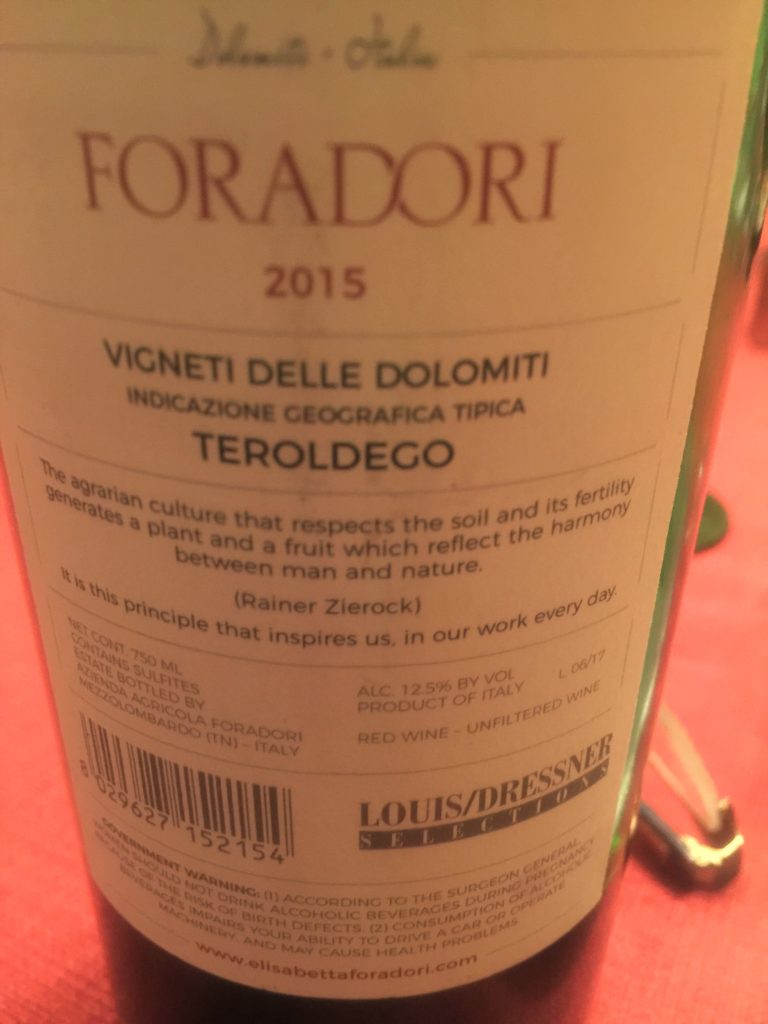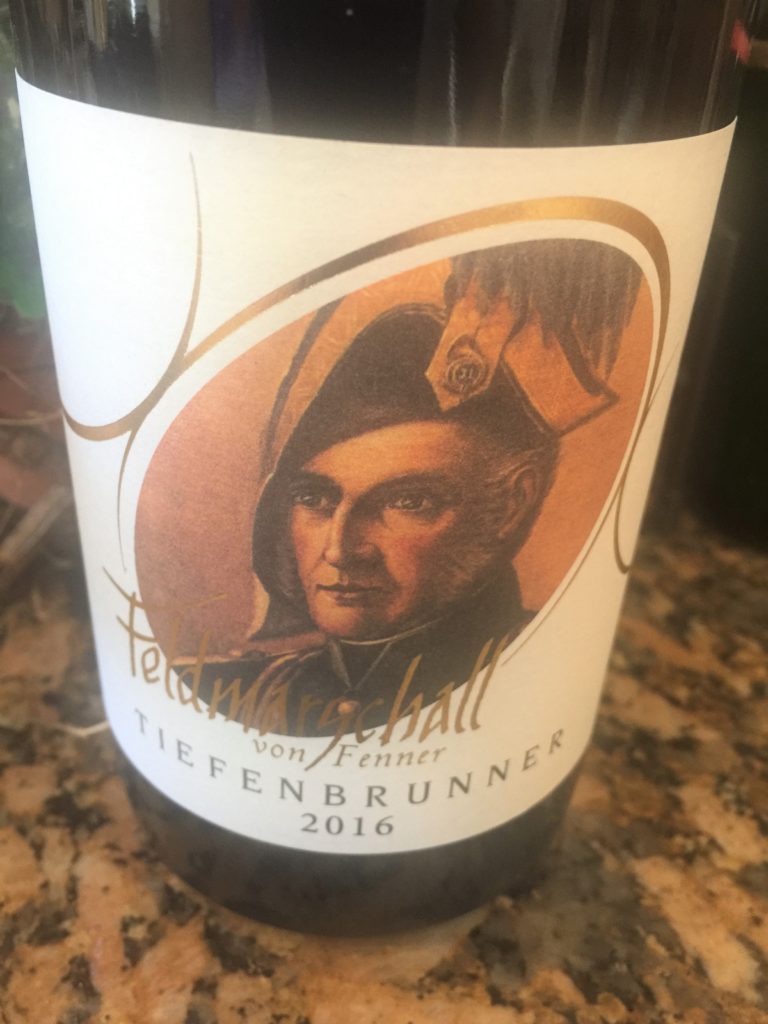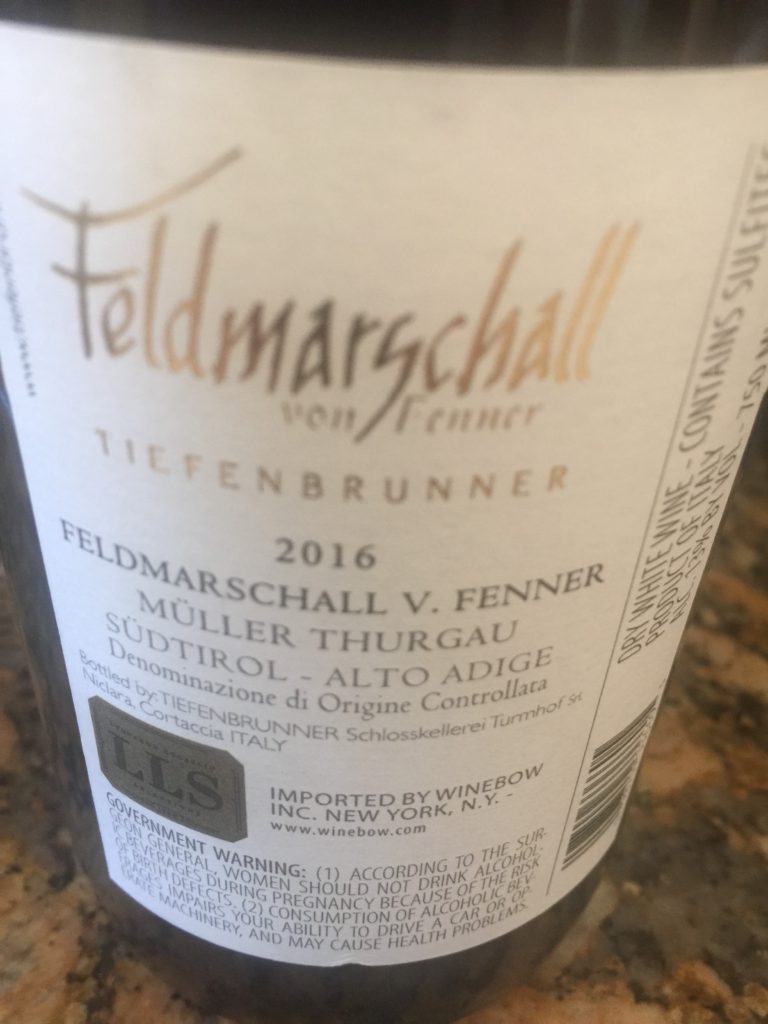If you think Italian Pinot Grigio is an inexpensive bulk-produced white wine for non-serious wine drinkers, then you probably have not had the “real deal” Pinot Grigio from Alto Adige. That is what I used to think, and promptly turned up my nose in true wine-snob fashion if offered a glass of Pinot Grigio. Then one day someone served me Pinot Grigio from an Italian wine region that was fairly close to being unheard of. Wow! I quickly decided that this is not a white Italian wine to be taken lightly, and that I had better learn something about where it came from. Alto Adige? Is that in Italy?
Alto Adige is located just at the very top northernmost part of Italy just below and bordering on Austria and Switzerland. It’s a little valley that used to be the main gateway between Italy and the rest of Europe. It has also been desired in war by many people from the ancient Romans to the Nazi regime. If you want to learn about Alto Adige, you also need to know a bit about her other half, Trentino, and what’s the connection to our new favorite Pinot Grigio from Alto Adige. Here is information for you about the region, the grapes, wines and the DOCs along with a few featured wineries and some of their wines. I hope you find it helpful and make you want to try the wine!
Trentino-Alto Adige
This region may be known as Trentino-Alto Adige, but it really is comprised of two separate provinces – Trentino and Alto Adige – that are joined together like twins. Trentino covers a 2,300 square mile area and is almost entirely Italian speaking while Alto Adige with 2,800 square miles is predominantly German speaking. In fact the German population knows their region as Südtirol or South Tyrol in English. Alto Adige was once part of the Austro-Hungarian Empire, but was reclaimed by Italy in 1919. About one million people live between the two provinces. Alto Adige is in the north and Trentino is in the south. The two are divided east from west by the Adige River, the second longest river in Italy, which is how Alto Adige (Upper Adige) got its name. The vineyards are in the valleys formed by the Adige and its tributaries. The rest of the provinces are quite mountainous; Trentino-Alto Adige is known for the beauty of its mountain peaks. Trento, the provincial and regional capital, sits on the banks of the Adige just downstream from the Istituto Agrario di San Michele all’Adige, Italy’s top winemaking school. Part of Trentino also borders on Lake Garda, a very picturesque scene between the high mountains. Trentino borders Lombardy to the west and Veneto to the southeast. Bolzano, located in the center of Alto Adige, is the capital of Alto Adige and the province of Bolzano.
The wines from these two provinces are also as dramatic and complex as their culture and political past. Germanic varieties such as Müller-Thurgau are prevalent in some of the region while the local Schiava grape is plentiful alongside more increasing vines of international grapes like Pinot Grigio, Chardonnay, Pinot Noir, Pinot Bianco and Sauvignon Blanc. Modern wine consumer preferences have also had great influence here just as in other Italian wine regions. Trentino-Alto Adige is the only Italian region with an increase in vineyard planting in the last quarter of the 20th century.
The region straddles the 46th parallel north and shares it’s latitude with central Burgundy. The valley floors heat up quickly in the mornings in summer which sends warm air up the slopes into the vineyards that are in rows ascending the sides of the valleys. There is bright sunshine which makes for rich ripe wine styles which is unexpected in an alpine climate. The warm alpine air also helps to save the vines from disease and fungus. The soil is alluvial and colluvial, free-draining and rich in minerals.
Winemaking in Trentino-Alto Adige
While we are enjoying our exceptional floral, fruity, fuller-bodied, food friendly acidic Pinot Grigio with “something to say”, get ready to familiarize yourself with a number of German-sounding wines like Gewürztraminer, Müller-Thurgau, Sylvaner and then there are the Italians like Schiava and Teroldego. After a while, you’ll be looking for your old friend Chardonnay. And that’s OK because there is a lot of it here, too.
Trentino is known for sparkling wine, Pinot Noir and Chardonnay – all international style – but if you go to Alto-Adige, you may think you have actually arrived in Germany. Winery estates in Alto-Adige are called “Schloss”, the German word for castle or chateau, and it is very common to see German names and words on the labels. Alto-Adige may be tiny with only 13,000 acres; however there is enough variation to have 7 different growing sub-regions. The area’s historic name is Südtirol (South Tyrol) from its Austrian past, and many of the people who live here are more familiar with goulash than polenta. This is also the land of speck, bresaola, Asiago, strangaolopreti gnocchi, and Knὂdel.
Wine was made here even before the Romans and possibly as long ago as the Iron Age. 2,500 year-old wooden barrels fitted with iron hoops were discovered in Alto Adige in 2002. Just like so many other wine producing regions, it was the knowledge of monasteries that improved and refined the local wine. Monasteries north of the Alps bought wineries in Alto Adige so they could have wine for mass. The largest wine press in Alto Adige may be in the Trostburg Castle in the Isarco Valley. The vineyards of Trauttmandsdorff Castle in Merano have conserved fifteen indigenous grape varieties from extinction including Blatterle, Jungferler, Fraueler and Gschlafenerr. You can see the “Versoaln”, one of the oldest grapevines in the world at the Katzenzungen Castle in Prissian. You can also taste the wine. There are numerous monasteries you can visit in the region.
Whether you are actually visiting monasteries in Trentino-Alto Adige, or at home sipping wine from the region, you will learn that some of their most important white grapes are Pinot Grigio, Traminer, Gewürztraminer, Sylvaner, Müller-Thurgau, Pinot Blanc and Chardonnay. Then there is Pinot Grigio! I hate to sound repetitive but this Pinot Grigio really is some of the best you will find. Twenty percent of the total wine production in Alto Adige is Pinot Grigio and Pinot Blanc. American Pinot Grigio may be less acidic than those of Alto-Adige and less expensive, but believe me, the Alto-Adige is usually worth every penny! The Pinot Grigio and Pinot Bianco have faint lemon and waxy peach aromas with slight honey and almond undertones. They are great rivals for Austrian Grüner Veltiner and German Riesling.
Traminer is a specialty in Alto Adige. It’s a sister of gewürztraminer and is known for making gorgeous floral, flavorful light white wines. Don’t be afraid to give Müller Thurgau a try here; it is nothing like the somewhat drab version from Germany. The indigenous reds can be very enjoyable, too. Be adventurous! Schiava, Teroldego, Lagrein, Tazzelenghe and Schioppettino all deserve to be tasted; however, you might have to work really hard to find some of them. A few producers to search out are Castel Schwanburg, Franz Haas, Hofstätter, Kuenhof, Alois Lageder, Tiefenbrunner and Elena Walch.
Schlosskellerei Tiefenbrunner
The Tiefenbrunner Castel Turmhof Wine Estate in now in its fifth generation of family operation. Sabine and Christof Tiefenbrunner say that it is a privilege and a duty to continue the story of their winemaking family. The Linticlar Estate was first mentioned in records dating from 1225. The castle ruins above the winery show that people have lived here since prehistoric times. The Turmhof was registered as a winery in 1848 making it one of the oldest wine estates in Alto Adige. Herbert Tiefenbrunner started work as a wine-maker before the end of WWII, and bought the winery in 1968. Sabine and Christof took it over in 2012. The winery produces over 20 types of wines with the flagship being the Müller-Thurgau “Feldsmarschall”. Their 60 acres of vineyards are located along the Wine Route of South Tyrol mainly on the mountain slopes around the castle. At 3280 feet above sea level, it is the highest vineyard in Europe. Production is 800,000 bottles a year.
That sparkling wine from the Trento DOC, or “Trentodoc” as local producers have more recently rebranded themselves, became very popular in the early twentieth century when Giulio Ferrari – sorry, he doesn’t make the cars! – pioneered sparkling wines in Trentino. Ferrari studied in France and thought there were a number of similarities between the Champagne and Trentino regions, and decided to bring Chardonnay to the area and make some traditional method sparkling wine just as he had learned in Epernay. Today Ferrari is still one of the best known and top sparkling wine houses of Italy. It seems that Ferrari put Trentino on the wine map. I’ve had a number of their sparklings and found them quite delightful! There are 50 wineries here producing 8 million bottles per year. Only a few of them export to the US – Ferrari, Altemasi and Rotari – so don’t expect to find it unless you make a major effort. I have purchased mine from internet wine sites like wine.com.
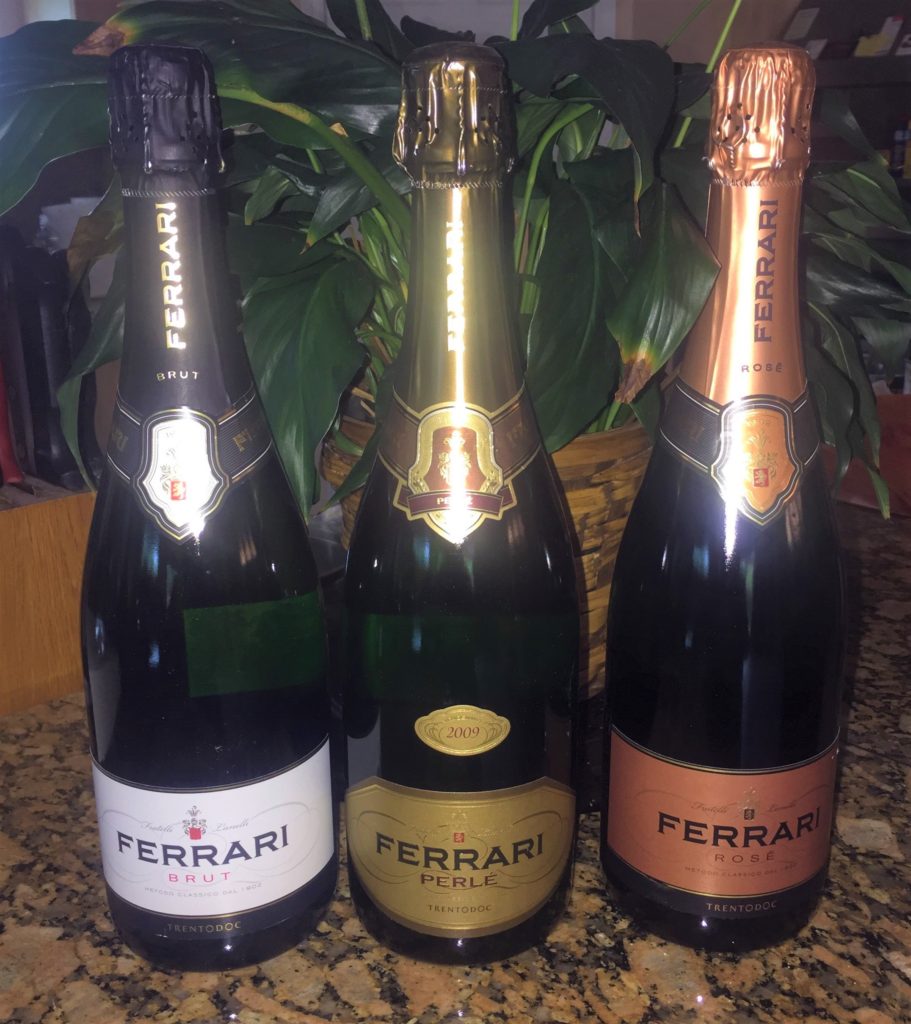
The Trentino DOC also produces a wide range of varietal wines from the light local Schiava to fine barrel-fermented Chardonnays. Then there is Teroldego in the north of Trentino that can be intensely fruity and deep-colored. Teroldego is a good example of what was old and out of fashion has now become new and popular once again. Elisabetta Foradori’s biodynamic estate at Mezzolombardo in Trentino is a good introduction to Teroldego. Foradori is considered the leading producer of Teroldego.
Foradori
Elisabetta Foradori is a key figure in Italian winemaking who put Trentino and its native grapes on the map. She is considered as one of the most influential female winemakers in the world. Her grandfather bought 15 hectares in Campo Rotaliano in the 1920s and sold wine in bulk. In 1960 her father learned oenology and put more ambition into the winery. Then in 1984 Elisabetta took over the winery. In 1986 she started making Granato old-vine Teroldego wine, which later became their flagship wine. After an “existential crisis” Foradori reconnected with the soil and by 2002 was running the entire domaine biodynamically and became fully certified by Demeter in 2009. The next important chapter was the use of clay amphorae to make natural wine. Now her son Emilio leads the winemaking working with his mother. Foradori is planted in 75% Teroldego, 15% Manzoni Bianco, 5% Nosiola and 5% Pinot Grigio which includes 9 leased hectares. The average annual production is 160,000 bottles of which 80,000 is estate Teroldego.
Foradori Teroldego Vigneti delle Dolomiti 2015
This Teroldego is sourced from 16 parcels including Mezzolombardo Campazzi, Settepergole and others. The soil is alluvial and gravelly-sandy. The fruit, 30% whole bunch, is fermented in concrete tanks then aged 12 months half in oak, half concrete. This is the signature wine and is juicy with a purity of dense red and black fruit, violets, a peppery edge and well integrated tannins. Alcohol is 12.5%.
One of the main distinctions between Trentino and Alto Adige is that in the north, wines are produced mainly by small family owned and managed wineries that sell their high quality wine mainly locally. Trentino has a number of growers who have all joined together in cooperatives that produce wines with consistent taste and characteristics every year. They are popular in Italy, but also abroad. These are some of the most exceptionally competent cooperatives in Italy. Bolzano, Caldaro, Colterenzio, Cortaccia, San Michele Appiano, Terlano and Termeno are all great examples. Cantina Terlano was founded in 1893 just above Bolzano at Terlan; they produce exquisite white wines especially Pinot Blanc from the terraced Vorberg vineyards. Cantina Caldaro overlooks Lake Caldaro and produces local reds such as Lagrein, Schiava and Sta Maddalene, which is 90% Schiava and 10% Lagrein. Count Michael Graf Goéss-Enzenberg’s “eco-sensitive” Manincor winery is in the area of Lake Caldaro. They produce excellent Pinot Noir, Moscato Giallo and Moscato Rosa. Alois Lageder’s Lὂwengang winery in the village of Magré was built in 1995 to strict environmental and ecological criteria. Then there is the historic estate of Foradori’s Hofstgatter built in 1907 in Tramin famous for Gewürztraminer, single-vineyard Pinot Noir Barthenau Vigna San Urbano and local Lagrein.
South of Trento near Volano is home to Eugenio Rosi, a controversial but authentic producer of the indigenous red grape Marzemino. The San Leonardo estate is further south near Avis and is home to one of northern Italy’s most famous Bordeaux-style wines.
Trentino’s terroir is very similar to Alto Adige except it is a little further down the valley and just a bit less ruled by mountains even though the mountain peaks are many thousands of feet above. Those high mountain peaks actually bring some protection from the elements keeping the vineyards free from rot and fungal disease. The capital city of Trento is one of Italy’s warmest cities in the summer. The valley floor heats up so much that you shouldn’t be surprised by the 104 degree temperatures in July.
Grape growers use the pergola trentina system of vine training in both Trentino and Alto Adige. This consists of high canopies supported on wooden arms high enough that people can walk under the vines without ducking, and with a dense leaf canopy that allows the fruit to ripen more slowly.
Grapes and wines of Trentino-Alto Adige
In 2017 Trentino-Alto Adige produced just over 11.3 million cases of wine. More than two-thirds of it was white. The primary grapes are Chardonnay (22%), Pinot Grigio (19%) and Schiava (9%).
The Grapes
WHITES:
Chardonnay: Now one of the most widely planted grapes in Trentino-Alto Adige (and Italy) due to the big boom of Spumantes in Trentino in the 1950s and 60s.
Gewürztraminer: It is traditionally off-dry with aromatics of fresh lychee, honeycomb and ginger. Alto-Adige is home to Gewürztraminer and was recently found to be the same grape variety as Traminer (Traminer Aromatico). You can find it mainly in the most southern wine area of Bassa Atesina which is warmed by Lake Garda. It is grown in both Alto Adige and Trentino.
Kerner: This aromatic white grape is named for Justinus Kerner, a 19th century German poet and writer of German drinking songs! It was bred in 1929 in Germany where it is grown widely, plus the Alto Adige, Austria, Switzerland, and a few unusual places like Japan. High in acid and able to age well, but as a varietal lacks the flavor and refinement of Riesling.
Müller Thurgau: This one is lighter and more flowery than Gewürztraminer. It has less alcohol and more citrus blossom aromas. It also grows in the Bassa Atesina wine-growing zone, but higher up as high as 4000 feet. The grape is a cross between Sylvaner and Riesling; it’s fairly widespread in northern Italy.
Moscato Gialla: A distinct sub-variety of Trentino-Alto Adige.
Nosiola: A tart native grape of Trentino.
Pinot Bianco: Widely planted in Italy, but extremely important in Alto Adige.
Pinot Grigio: This grape can be rich and potent, but lots of it is made into a thin high acid wine. Not the rule in Alto Adige!
Sauvignon: Sauvignon Blanc has become quite popular in northern Italy.
Sylvaner: Mainly found in the Isarco Valley of Alto Adige; probably brought there from Germany.
REDS:
Cabernet: Both Cabernet Sauvignon and Cabernet Franc were brought here from France before but especially after the deadly phylloxerra. They are both widely planted.
Casetta: A native grape of Vallagarina between Trento and Verona. One of its synonyms is Lambrusco a foglia Tonda which is not the same as Enantio/Lambrusco a foglia Frastagliata grapes. The berry is black medium-large with medium thin blue-black skin. The vine does best in hilly terrain, no more than 400 meters above sea level and with good exposure. It makes intense ruby red wine, fruity with plant notes, good tannins, rich in alcohol and acidity. Find it in Valdadige Terradeiforti DOC and Vallagarina IGP.
Lagrein: This is an ancient native varietal grape with mention as far back as the 1500s. There are only 1100 acres of it in Alto Adige, Trentino’s Campo Rotaliano plain and that may be it for the whole world, so it is hard to find. It needs intense heat to ripen, and thrives in the sandy alluvial soils of the plains near Bolzano. It’s made into a dark dense red wine with earthy pepper notes, relatively high tannin and acidity and called scuro (Dunkel). “Scuro” means dark in Italian; “dunkel” means dark in German. Like Teroldego it is usually deeply flavored with some spice on the finish and pairs up well with a rich braised meat or stew. It also makes a spicy fragrant full of flavor rosato (Kretzer). All in all it’s a good wine to tuck away in your cellar. Some say it tastes similar to French Syrah and Italian Barbera.
Marzemino: Grows primarily in Trentino around Isera but also in the Veneto, Lombardy and Emilia-Romagna. It has a grassy, herbal element and sour cherry tang. Its biggest claim to fame is in the sweet Colli di Conegliano Refrontolo passito wines of the Veneto.
Merlot: Grows easily here and is one of the most widely planted red grapes in Italy.
Pinot Nero (Pinot Noir): Another one of the international grapes of French origin and is considered one of the noble red grapes. It is difficult to grow and a challenge from vintage to vintage and area to area due to climate and soil conditions. You will find it in Italy mainly in Trentino-Alto Adige and Collio Goriziano, but there are some winemakers attempting to grow it as far south as Tuscany. Lombardy winemakers make their classic Franciacorta DOCG sparkling from Pinot Noir, and the Pinot Nero dell’Oltrepò Pavese DOC has been in existence since 2010.
Schiava (Vernatsch): This is the most widely planted grape in Trentino-Alto Adige and is probably of Slavic or German origin. 73% of Italian Schiava grapes grow in Trentino-Alto Adige. The other 21% are in Puglia. The best place to find it is in the Lago di Caldaro DOC and the Santa Maddalena subzone.
Teroldego Rotaliano: Mostly grown in the Campo Rotaliano plain of northern Trentino; possibly related to Marzemino grape variety.
The wines
Alto Adige
The majority of wines produced in this DOC are also covered by smaller DOCs and several IGPs that are more specific to area and wine style. This is quite unique in Italy’s wine regions. The same is true for Trentino. And then there are sub-zones! It is quite possible you will find a bottle of wine labeled Alto Adige DOC …..plus the name of the specific DOC ……. Plus the name of the sub-zone…….. and oh yes, probably with the addition of names in German! Just for more “fun”! Schiava and Lagrein are the dominant local grapes and the standard French origin international grapes plus the popular German varieties.
ALTO ADIGE WHITE WINES
The Alto Adige DOC is home to 11 white grape varieties including Chardonnay, Müller-Thurgau, Sauvignon, and Pinots Grigio and Bianco. The big difference is which grapes producers here focus on, and as we indicated before, the greater use of German on the label. Some producers age their Chardonnays in oak while others use stainless steel. The same is true for Sauvignon, but stainless steel seems to be the more preferred method. These are the most appealing and popular wines – and they are bright, acidic and tingly. Alto Adige also makes a lot of single-vineyard cru wines and special blends, which do use more oak and are heavier on the palate. Pinot Bianco wines are especially affected by this; they respond quite well to fermenting and oak aging. Also Pinot Bianco gives a good crop every year and it’s really versatile.
Fritz Kupelwieser
Fritz Kupelwieser planted his Alto Adige vineyard in 1878. The current wines reflect his dedication and commitment and serve as a reminder of Fritz’s philosophy. The wines are fresh and lively and the winery approaches them with elegance and style right down to the stylish design of the bottles. Kupelwieser makes white wines of Chardonnay, Gewürztraminer, Müller-Thurgau, Pinot Bianco, Pinot Grigio, Riesling and Sauvignon and reds from Lagrein and Pinot Noir.
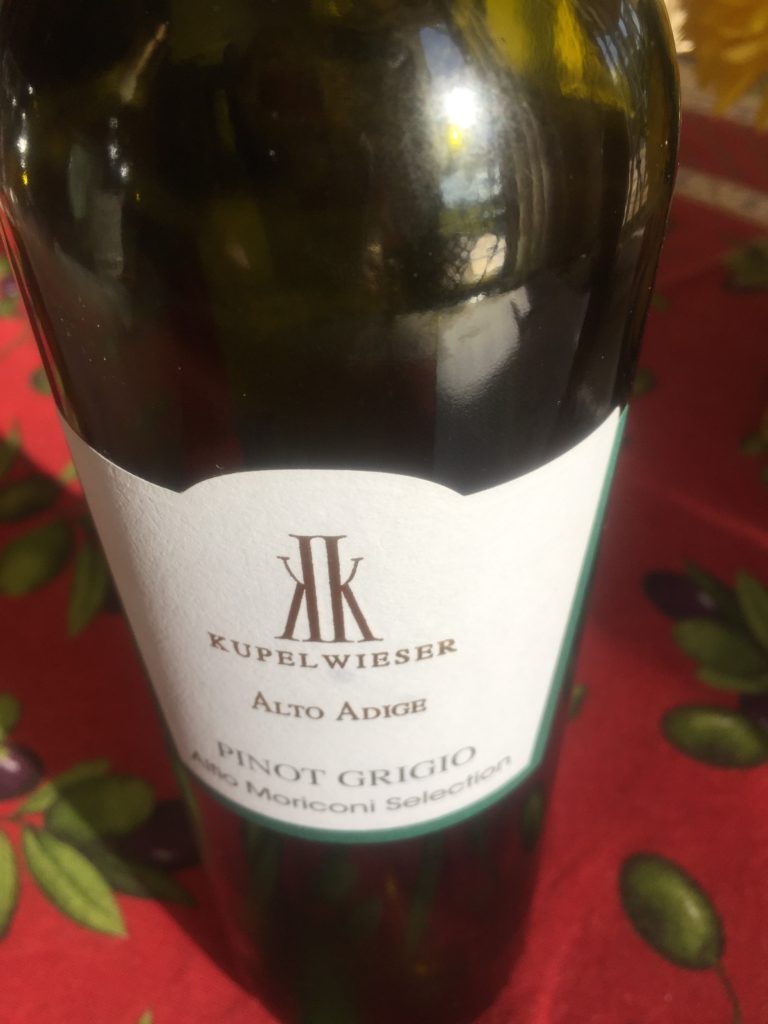
Kupelwieser Pinot Grigio Fritz Alto Adige 2017
Fritz Pinot Grigio comes from vineyards on the valley floor of the “Lowlands” of Alto Adige. The low grape yield per hectare of 60 hl ensures the wine’s high level of quality. The grapes are gently pressed and naturally clarified. Fermentation takes place with pure strains of yeast at 66 degree F. temperatures. The result is a straw yellow wine with rich aromas of delicate fruity with subtle tones of pears, excellent acidity and a soft but full dry finish. You can cellar this Pinot for 2-3 years.
Abbazia di Novacella Stiftskellerei Neustift
This abbey was founded in 1142 by the Augustinian order of Canons Regular. You can find it in the little town of Novacella in the Isarco River Valley. The Isarco (also known as the Eisack River) is the second largest river in South Tyrol. Abbazia di Novacella is a huge complex including a two -story gate chapel, church, library, museum, gardens, convention center, boarding school, restaurant, gift shop, and………….a wine estate! In fact the winery has been known for many years as a producer of world class white wines. Italy’s Gambero Rosso named Celestino Lucin, the abbey’s winemaker, as the 2009 Winemaker of the Year. The white grapes grow on 6 hectares around the abbey in the northernmost vineyards of Italy at elevations of 1970 – 2950 feet and 15 hectares of red grapes further south in the warmer central region near Lago di Caldaro and Bolzano. They also work with 50 small growers in the region. The soil is mainly granitic schist created by ancient glaciers and the vineyards are very steep. The vines here produce wines that are aromatic, fresh and rich. They may have been making wine for over 850 years, but their cellar is entirely modern and they farm organically. Production includes Pinot Grigio, Kerner, Sauvignon, Schiava, Gruner Veltliner, Lagrein, Pinot Nero and Moscato Rosa.
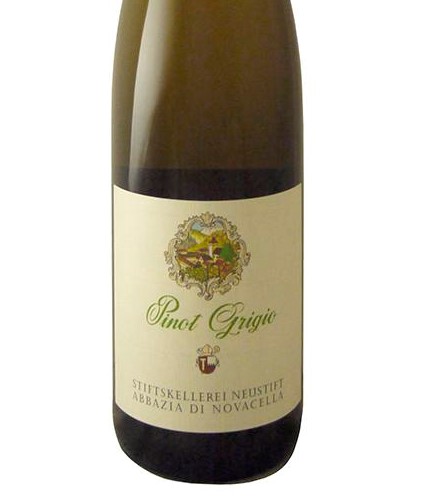
Abbazia di Novacella Pinot Grigio Valle Isarco Alto Adige 2015
This Pinot Grigio from the Abbazia di Novacella in the Isarco Valley grew in gravelly soil between 1969 – 2461 feet above sea level with a south-southwest exposure. Two-thirds of the wine was fermented and stored in stainless steel tanks; one-third in 30 hectoliter oak casks for 6 months. It was made with natural and selected yeasts. We can expect a straw yellow color with aromas of citrus fruits, peaches and honeydew melon; medium rich and fruity on the palate with orchard fruit flavor and a tangy, acidic, full and elegant finish. Alcohol level is 13% and it received 92 points from James Suckling; 91 W & S and 90 from WE.
Gewürztraminer is the symbol of Alto Adige wine culture. The grape Traminer may well have come from the town of Tramin (Termeno). Its heavy aromas and flavors can be the perfect match for the heavy mountain foods of the area like gnocchi with wild herbs and smoked sausages. It also goes well with cinnamon which is used a lot in the cooking of Alto Adige.
Cantina Tramin Kellerei
Tramin Winery represents one of the oldest networks of farmers forming a co-operative winery. It was founded in 1898 by Pastor Christian Schrott and now has 290 members across approximately 620 acres in the communities of Tramin, Newmarkt, Montan and Auer. The philosophy of the co-operative is that the farmers operating individually on their small estates allows for hard work, dedication, creativity and pride. The town of Tramin (the German name for Termeno) is home to the Gewürztraminer grape, and claims the best vineyards of that grape are planted around the village on the west bank of the Adige Valley. Cantina Tramin built a new headquarters that opened in 2010 that incorporates the original cellar into a striking new building that even features a luminated glass bubble suspended between heaven and earth that allows visitors to have a panoramic view of the foothills, orchards and vineyards. Tramin produces many other fine white, red and sweet wines from grapes that thrive in this region.
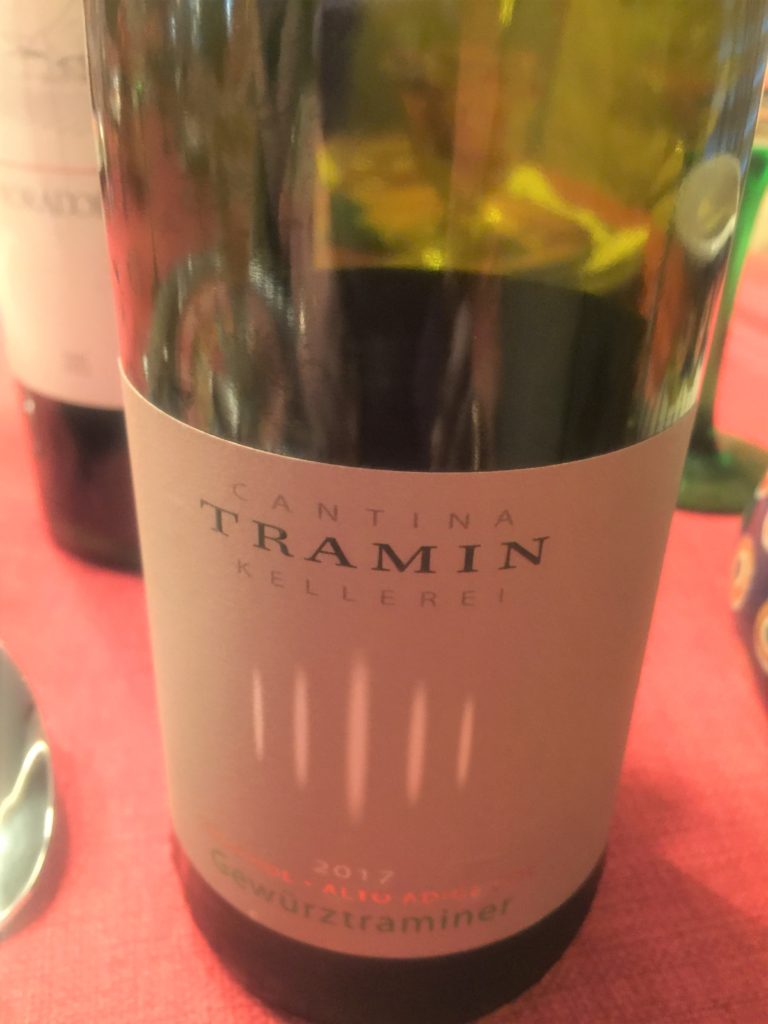
Cantina Tramin Kellerei Gewürztraminer Alto Adige 2017
This is a 100% Gewürztraminer that came from 100 acres of vineyards in calcareous and clay soils of Alto Adige at an altitude of 990 – 1485 feet above sea level. The grapes were fermented in stainless steel tanks for 10 days at a controlled temperature of 70 Degrees F. It was then aged for 5 months before bottling. The resulting wine is straw-yellow in color with scents of peach and fresh cut grass over subtle hint of white spices. It has a balanced acidity and weighty texture. Tropical flavors of lychee and starfruit on the palate complement the delicate floral finish. 300,000 bottles were produced.
Sylvaner is another aromatic white of Alto Adige you should search out, especially those wines from the Val d’Isarco/Eisacktaler sub-zones of the Alto Adige DOC. The Isarco Valley offers one of the most beautiful mountainous natural landscapes in Alto Adige, with alpine farmhouses, castles, monasteries, villages, and terraced vineyards enclosed within neat low stone walls. The vineyards are on the steep mountain slopes at heights of up to 950 meters. The long narrow Isarco Valley, located northwest of Bolzano, was an independent DOC until 1993 when it became a sub-zone. In addition to the Sylvaner, you will also find Gewürztraminer, Kerner, Müller-Thurgau, Pinot Grigio and Riesling, plus Klausner Laitacher. Just in case you aren’t familiar with that one – I sure wasn’t!! – Klausner Laitacher wine is made following an ancient Isarco Valley tradition. It consists of a blend of Schiava, Lagrein, Pinot Nero and Blauer Portugieser resulting in an elegant wine with a charming fresh fruit note.
Tiefenbrunner Merus Pinot Bianco South Tyrol/Alto Adige DOC 2017
The “Merus” is made from 100% Pinot Bianco grapes grown on hillside vineyards in Cortaccia’s chalk gravel moraine soil and the sandy alluvial soil of valley floor locations near Magre from 688 – 1968 feet altitude. The grapes went through temperature controlled fermentation in steel tanks followed by four-month aging on the fine lees in concrete vats prior to bottling. The resulting wine is fresh and elegant with pale yellow color, flowery, fine and fruity notes of apple and tropical fruits, and fresh minerally acidity with a harmonious finish. Alcohol is 13%.
Tiefenbrunner Vigna Feldmarschall Von Fenner Müller-Thurgau 2016 South Tyrol/Alto Adige DOC
The Vigna is made from 100% Müller-Thurgau grapes at 3280 feet above sea level. The red soil is characterized by glacier moraine rock, silty-loamy sand, some white and red marble, granite rocks, dolomite and limestone. The soil also has a high salt content which adds to the fruit and herb aromas. After the grapes are gently pressed, one half is left to ferment in a large wooden barrel and one half in a stainless steel tank. There is no added yeast. The wine then rests on the lees for just under a year. After that it spends another 6 months in the bottle. The bottles are closed with screw caps to preserve the aromatics. The final result is a light straw yellow wine with notes of white flowers and yellow fruits, peach and apricot and fresh acidity. Mineral notes become more prominent as it ages. You can cellar this wine for 10 years or more. Alcohol is 13%. 13,000 bottles were produced. Wine Enthusiast rated this wine at 94 points.
ALTO ADIGE RED WINES
Schiava is the most widely planted variety and wines based from Schiava remain pretty much a local choice. Schiava makes a fruity light to medium- bodied red wine with intense strawberry, cherry, cranberry, almond, violet, red currant, and pomegranate. It is low in alcohol and tannin and is often blended with something more robust like Lagrein.
Kupelwieser Lagrein “Fritz” Alto Adige 2016
Lagrein is unique to Alto Adige and grows well in the loamy soils of the Val d’Adige valley. The low yield of 65 hl per hectare ensures an outstanding quality wine. The destemmed grapes are fermented at 79-82 degrees F for about 8-10 days. The must is kept in contact with the skins. After two rackings, 70% of the wine is aged for 12 months in large oak barrels and the rest in 2-3 year old small French oak barriques. The wine is placed in Bordeaux-style bottles and then aged for 6 more months before going to market. The resulting wine is ruby to dark garnet red in color with intense, complex, spicy aroma and fresh perfume of wild berries and violets. It has a good amount of tannins, soft velvety body with a lightly spicy finish. You can cellar the Lagrein for 6-8 years.
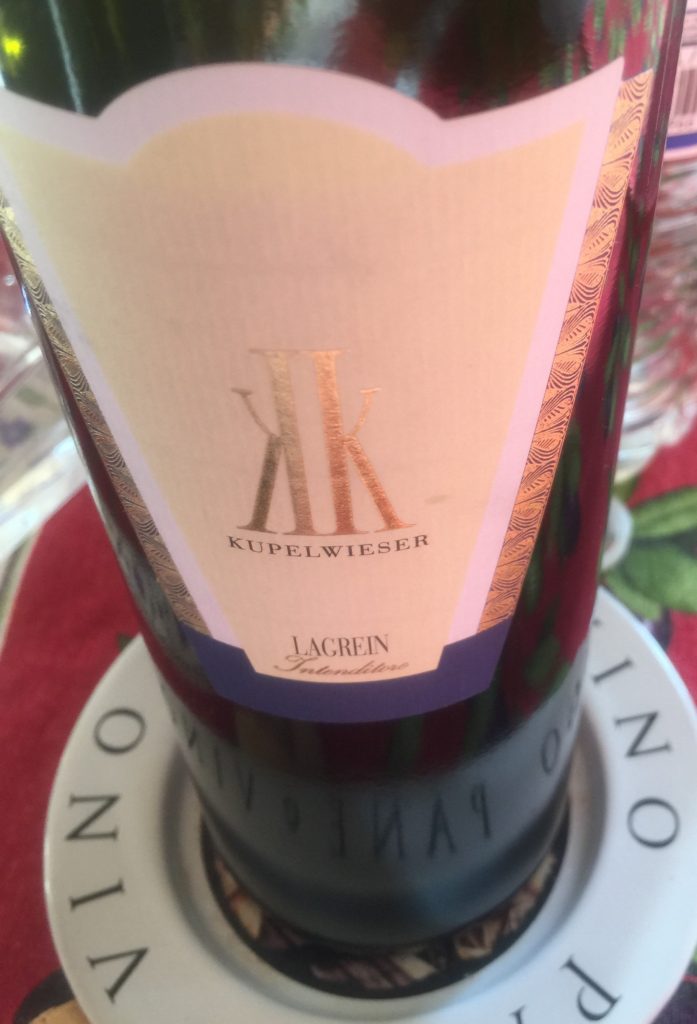
Cabernets and Merlot may be the most popular international grapes here but Pinot Nero seems to be the best suited. Pinot seems to thrive in this altitude and climate. Many of the Cab blends made here have a vegetal aroma and flavor not unlike green bell peppers which is not popular with some Cabernet drinkers.
Tiefenbrunner Turmhof Blauburgunder Pinot Nero 2017 South Tyrol/Alto Adige DOC
There are only a handful of red grapes in the acres and acres of Turmhof Vineyards. These 100% Pinot Nero grapes came from 6 acres at 1470 – 3200 feet above sea level. The grapes were fermented on the skins in stainless steel tanks for 12 days, and then aged in barriques and barrels for 8 months. Bottle aging lasted 4 months. The wine is ruby red with garnet tones, aromas of raspberries, red cherries, strawberries and violets. It is smooth with red berry flavors balanced with crisp acidity and soft round finish. Alcohol is 13.5%. 39,000 bottles were produced. Tiefenbrunner is considered a “Green Attitude” wine by LLSGreen Attitudes tool designed by Winebow.
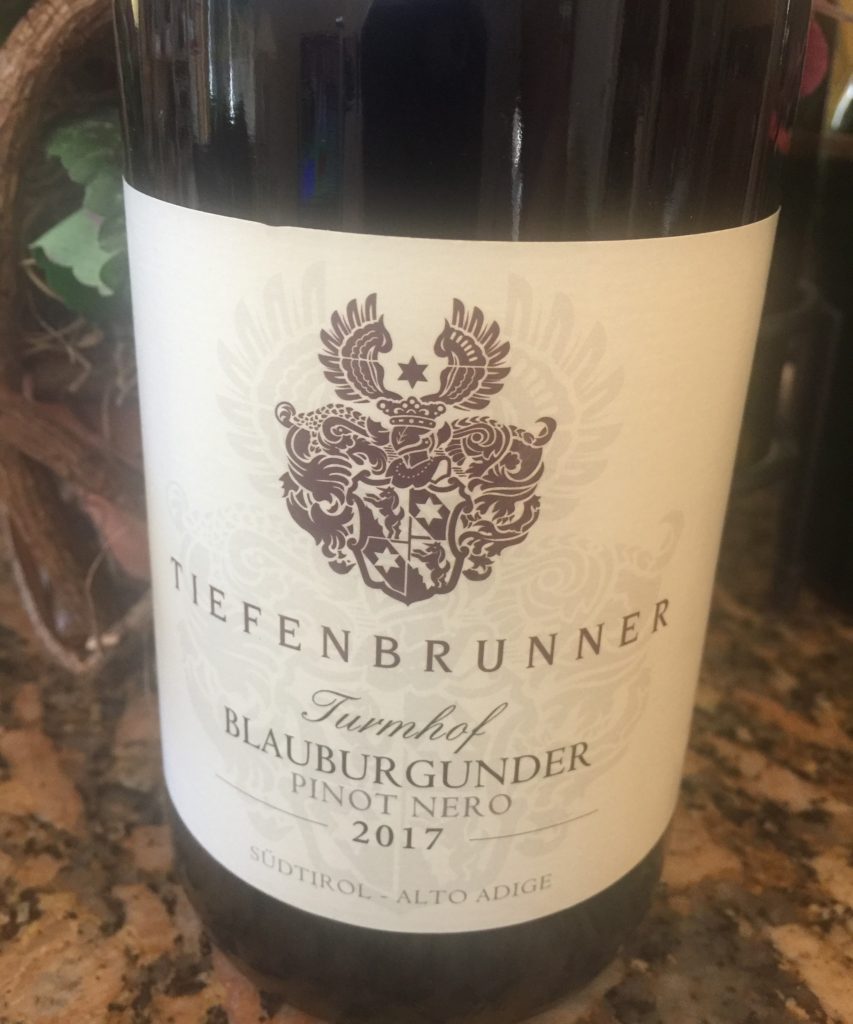
Trentino
Trentino has a wide range of varietal wines with 20 specified made from local grapes like Schiava, Teroldego and Lagrein, and international varieties of which Chardonnay and Pinot Noir are most used. The standard Trentino Rosso is made from Cabernet grapes with some Merlot added for good measure. Trentino Bianco is a base blend of Chardonnay and Pinot Bianco with Sauvignon Blanc, Müller-Thurgau and Manzoni Bianco as possible additions. There are 10 dry white varietals.
TRENTINO WHITE WINES
Chardonnay, Pinot Grigio and some Pinot Bianco are most planted at the lower elevations, because they can handle the occasional intense heat and humidity of the valley floor. The majority of Chardonnay producers strive for fresher, fruitier wine with emphasis on acidity. The best ones are somewhat like young Chablis wines.
The aromatic whites are the most interesting: Sauvignon Blanc, usually called just Sauvignon – both in Trentino and Alto Adige; Nosiola – Trentino’s true native white; and Müller-Thurgau – can be excellent in both Trentino and Alto Adige. Sauvignon is usually more restrained here than in Friuli due to the Alto Adige gravel limestone soil and the balance of the cooler climate.
Trentino DOC Nosiola is grown mainly on hillsides around the shores of Lake Garda and the Val di Cembra. Nosiola wine is super tart, light bodied with lemon-apple flavor and mineral finish. You should absolutely love it especially if you are drinking it in the place where it is grown! Its partially dried grapes make excellent Trentino DOC Vino Santo.
The Muller-Thurgau is a more exotic grape; Trentino may be its ideal habitat! This is the only variety growing in the Tyrols that thrives at the highest altitudes of 500 meters and up. It is at its best in Val di Cembra, and a great wine to try is Pojer & Sandri. Trentino Müller-Thurgaus keep their exotic aromas of dried apricots, white flowers and wild herbs but without being too heavy. The Val di Cembra Valley is in a deep basin created by the Avisio River a long time ago. It has gentle rolling hills, lakes, woods and meadows with the Dolomites towering high above and is known for fertile soils and an ideal wine-growing region. High quality wines and exquisite grappa come from this valley. If you are a tourist, you must see another one of the valley features – “The Pyramids of Segonzano” which are pinnacles of earth with very suggestive shapes, as a result of the disintegration of the mountains and action of the water over thousands of years. The vineyards are on wide dry terraces marching up and down the steep slopes. In fact the Cantina della Valle di Cembra, the Cembra Mountain Wine Cellar, is the winery located at the highest altitude of Italy, a mere 700 meters above sea level or 2300 feet. This winery is renowned for their Müller-Thurgau for which the Rassegna dei Müller-Thurgau dell’Arco Alpino – a special festival to celebrate the Müller-Thurgau – takes place every year.
TRENTINO RED WINES
Schiava, Teroldego and Lagrein are the local red wines you will find here along with international red varieties of which Pinot Nero is the most widely used. Cabernet varietals can be made from any combination of Cabernet Sauvignon, Cabernet Franc and Carmenere as long as there is 85% of the main grape. The dual varietal of two Cabernets has also become popular. All they need is 50-75% of the first named variety. There is a lot of Merlot in the standard Rosso to make it somewhat like a Bordeaux blend. The Casteller DOC produces only red wine made from Schiava, Lambrusco a Foglia Frastagliata (also known as Enantio), Teroldego and 50% minimum of Merlot. The Caldaro DOC produces only red wine made from Schiava. And guess what red wine they produce in the Teroldego DOC? That’s right, 100% Teroldego! All of these wines go well with the mountain dishes of Trentino like canederli known as knὂdel in German.
The wine growing regions of Trentino-Alto Adige
Trentino-Alto Adige consists of 9 DOCs, no DOCGs and 4 IGPs. Ninety-one (91%) of those 11.3 million cases of wine produced in 2017 were at the DOC level, which is the highest percentage of any Italian region. The proportion is typically between 5 and 40%.
The focus here is definitely white wine; two-thirds of the production was white. The majority of wines produced in Alto Adige are covered by several DOCs which is very uncommon in Italy. Close behind is Trentino with almost three-quarters of its wine produced coming from one of the smaller DOCs that are very specific in area and style: Teroldego Rotaliano, Caldaro, Casteller and Valdadige.
Alto Adige/Südtirol DOC – All of Alto Adige Province
There are over 11,000 acres of vineyards in this DOC established in 1975. Almost 3.3 million cases of wine produced in 2017. The Alto Adige DOC covers the majority of wines made in this region. The principal white grapes are: Chardonnay, Gewürztraminer, Kerner, Moscato, Müller-Thurgau, Pinot Bianco, Pinot Grigio, Riesling, Sauvignon Blanc, Sylvaner and Italian Riesling (Welschriesling). Principal red grapes are: Cabernet Franc, Cabernet Sauvignon, Lagrein, Malvasia Nera, Merlot, Moscato Rosa, Pinot Nero, and Schiava. They produce whites in blends and varietals, rosato, reds in blends and varietals, sparkling, dessert and specialty wines. Spumante wines must undergo their second fermentation in the bottle (Metodo Classico) and cannot be sweeter than Brut. There are also a number of sub-zones, all with Italian and German names, that are for more specific grapes:
Colli di Bolzano/Bozner Leiten: for the varietal Schiava only.
Meranese di Collina/Meranese/Meraner Hügel/Meraner: for the varietal Schiava only.
Santa Maddalene/St. Magdalener and Santa Maddalena Classico: for varietal Schiava only.
Terlano/Terlaner and Terlano Classico: all white nonsparkling types (including Vendemmia Tardiva, Passito, and Riserva) made from Chardonnay, Müller-Thurgau, Pinots Bianco and Grigio, Riesling, Sauvignon Blanc and Sylvaner Verde.
Valle Isarco/Eisacktal/Eisacktaler: all white nonsparkling types (including Vendemmia Tardiva, Passito and Riserva ) made from Gewürztraminer, Kerner, Müller-Thurgau, Pinot Grigio, Riesling, Sylvaner and/or Veltiner; also Klausner Laitacher.
Valle Venosta/Vinschgau: all white nonsparkling types made from Chardonnay, Gewürztraminer, Kerner, Müller-Thurgau, Pinot Bianco and Grigio, Riesling, Sauvignon Blanc; also varietal Pinot Nero and Riserva, and Schiava
Casteller DOC – Trentino Province
These 62 acres of vineyards became a Trentino DOC in 1974. Only these red wines can be produced: 50% minimum Merlot; and a maximum of 50% from Schiava, Lambrusco a Foglia Frastagliata (Enantio) and/or Teroldego. Almost 27,000 cases were produced in 2016.
Delle Venezie DOC – Trentino Province, all of Friuli Venezia Giulia and Veneto
This is a cross-regional DOC created in 2017 often referred to as the Pinot Grigio DOC as it elevated Pinot Grigio from IGP delle Venezie. It includes 62,000 acres of vineyards producing 20 million cases or more. White grapes allowed are: Chardonnay, Friulano, Garganega, Müller-Thurgau, Pinot Bianco, Pinot Grigio and Verduzzo; they may be produced as a blend, varietal, and Pinot Grigio Spumante.
Lago di Caldaro/Caldaro/Kalterersee/Kalterer DOC – Trentino Province
1000 plus acres of vineyards in the Trentino Province were established as a DOC in 1970 to make red Rosso, Scelto or Auslese from the Schiava grape. Classico can be produced from the sub-zone communes of Appiano, Bronzolo, Caldaro, Cortaccia, Egna, Montagna, Ora, Termeno and Vadena. 294,000 cases were produced in 2016.
Teroldego Rotaliano DOC – Trentino Province
1000 acres were established as a DOC in 1971 to specifically make wine only from the red Teroldego grapes grown on the Campo Rotaliano plain of the Adige Valley in northern Trentino. Wine can be Rosso, Superiore, Riserva or Rosato but must be 100% Teroldego. The communes here are Mezzolombardo, Mezzocorona and the village of Grumo which belongs to the San Michele all’Adige commune. These wines have become something of an icon for Trentino’s wine industry. 360,000 cases were produced in 2016.
Trentino DOC – All of Trentino Province
There is one large regional DOC (granted in 1971) covering all of the province of Trentino. It includes over 16,000 acres of vineyards that produced over 3 million cases of wine in 2017. There are vineyards from the valley floor to 100 meters in elevation. There are 20 specified varietal wines made from blends, whites, rosato, reds, dessert and specialty wines. The whites: Chardonnay, Gewürztraminer, Kerner, Manzoni Bianco, Moscato, Müller-Thurgau, Nosiola, Pinot Bianco, Pinot Grigio, Riesling, Sauvignon Blanc, Sylvaner and Welschriesling; and reds: Cabernet Sauvignon, Cabernet Franc, Carmenere, Lagrein, Lambrusco, Marzemino, Merlot, Moscato Rosa, Pinot Nero, Rebo, Schiava and Teroldego. There is also a Trentino Superiore DOC. The smaller DOCs of Trentino (Teroldego, Caldaro, Casteller and Valdadige) focus on specific areas and wine styles. Almost three-quarters of wine produced here qualifies for one of these DOCs, which is a much greater amount than other Italian regions and second only to Alto Adige. And then there are sub-zones:
Castel Beseno or Beseno: Moscato Giallo Superiore, Passito and Vendemmia Tardiva only.
Isera: for Marzemino Superiore only.
Sorni: Sorni is a small sub-zone just east of the Adige Rive. The vineyards are in Lavis, Giovo and San Michele all’Adige. The Istituto Agrario di San Michele all’Adige wine school is located here. This is one of the hottest places in July on the Italian peninsula especially near San Michele all’Adige making the wines here noticeably fuller and more mature in style. They make Bianco and Rosso wines only in Sorni.
Valle di Cembra or Cembra: Müller-Thurgau, Riesling Renano, Pinot Nero and Schiava Superiore.
Ziresi: Marzemino Superiore only.
Trento DOC – Trentino Province
Trento was established as a sparkling wine DOC in 1993 and includes just over 2,000 acres of vineyards. It produced almost 700,000 cases in 2016. It is famous for sparkling wine made from Chardonnay, Pinot Bianco, Pinot Meunier and Pinot Nero. All wines must undergo second fermentation in the bottle by use of Metodo Classico.
Valdadige Terradeiforti/Terradeiforti DOC – Trentino Province and Verona Province in Veneto
Previously a sub-zone of the Valdadige DOC and established as a separate Trentino DOC in 2006. It’s only 52 acres of vineyards and officially allowed to produce six types of wine: three varietals – Enantio (Lambrusco a Foglia Frastagliata), Casetta and Pinot Grigio – as well as red aged riserva and white superiore. The Enantio grape can only be found here in Trentino. It is deep red and makes intensely colored wine. Casetta is equally unknown and wasn’t even officially recognized in the DOC regulations until 2002. Part of the communes are located in the Veronese province in the far north-western corner of Veneto.
Valdadige/Etschtaler DOC – Trentino Province and Verona Province in Veneto
This is an inter-regional DOC granted in 1975 that shares 2720 acres of vineyards within the provinces of Alto Adige, Trentino and Verona in the Veneto wine region. It includes the Terradeiforti communes of Brentino, Belluno, Doce and Rivoli across the regional border in north-western Veneto. 1.4 million cases of blended and varietal wine were produced in 2017 from the principal allowed grapes of Chardonnay, Garganega, Müller-Thurgau, Nosiola, Pinot Bianco, Pinot Grigio, Sauvignon Blanc, Trebbiano, Italian Riesling, Cabernet Franc, Cabernet Sauvignon, Lagrein, Lambrusco (Enantio), Merlot, Pinot Nero, Schiava and Teroldego.
Mitterberg IGP – Alto Adige Province
This tiny IGP includes just 61 acres of vineyards in the entire province of Alto Adige and produced about 38,000 cases in 2016. Created in 1995 to cover white and red blends and varietals, rosato, dessert and specialty wines limited to: Chardonnay, Gewürztraminer, Kerner, Moscato, Müller-Thurgau, Pinot Bianco, Pinot Grigio, Riesling, Sauvignon Blanc, Sylvaner, Italian Riesling, Cabernet Franc, Cabernet Sauvignon, Carmenere, Lagrein, Malvasia Nera, Merlot, Moscato Rosa, Petit Verdot, Pinot Nero, Schiava, Syrah and Teroldego.
Trevenezie IGP – Trentino Province and all of Friuli Venezia Giula and Veneto
This geographical area was originally established as IGT delle Venezie in 1995 but renamed when Delle Venezie DOC was split off in 2017. It is the same zone as the old IGP and the new DOC. There are many Italian and international grapes permitted; however the exact list varies by province. Trevenezie Includes over 12,000 acres of vineyards and produced over 18 million cases in 2016.
Vallagarina IGP – Trentino Province and Verona Province in Veneto
This is a 422 acre inter-regional IGP established in 1995 to include Trento (Trentino-Alto Adige) and Verona (Veneto). It covers the Vallagarina district in southern Trentino and is named after the Lagarina Valley where the Adige River flows through the Limestone Alps down into Verona. Vallagarina wines can be made in any one of various styles: red, white, rosato, blend, varietal, still, sparkling or sweet; however Pinot Grigio, Casetta, Teroldego, Marzemino, Merlot and Cabernet Sauvignon are most used. Vallagarina produced almost 31,000 cases of wine in 2016.
Vigneti delle Dolomite/Weinberg Dolomiten IGP – Trentino-Alto Adige and Belluno Province in Veneto
This is a 2800 plus acre inter-regional region established in 1997. Over 2 million cases were produced in 2016. Vine growing here can be traced back to the Ancient Bronze Age (1800-1600 BC). The harvest rules date back to the medieval period when the “Statutes of Trento” were issued in the twelfth century. Wines can be made from these grapes: Chardonnay, Friulano, Glera, Kerner, Malvasia, Manzoni Bianco, Moscato, Müller-Thurgau, Nosiola, Pinot Bianco, Pinot Grigio, Riesling, Sauvignon Blanc, Sylvaner, Barbera, Cabernet Franc, Cabernet Sauvignon, Carmenere, Casetta, Franconia, Groppello, Lambrusco, Malvasia Nera, Merlot, Moscato Rosa, Petit Verdot, Pinot Nero, Rebo, Schiava, Syrah and Teroldego. Style can be white, rosato, red, blend, varietal, sparkling, dessert and specialty wines generally based on the requirements of the province.
La Strada del Vino
The strada del vino or wine road (Weinstrasse) is well marked especially in Alto Adige. It runs from Salorno to Balzano and will take you through a number of picturesque wine villages. There are small lodges in both provinces and many of the wineries have shops and restaurants attached. The wine trails take you right through some of the top vineyards. If hiking and skiing is also your thing, there are plenty of options for that in the nearby Dolomite mountains. In any case, you will find some of the most beautiful vineyards and breathtaking views in the world here. And then there is the food! Food Festivals of Trentino-Alto Adige are held three times a year. The La Casolara (Cheese Sunday) is held in Trento on the first Sunday of Lent in February. The festival offers guided cheese tasting with the best wines of the area. In September in Trento there is the Strudel, Muscat and Vin Santo Wine Festival. In April it’s the Nosiola Fair at the Castle Toblino. Sounds like the best of everything!
Trentino-Alto Adige: the perfect conclusion to our Tre Venezie adventure
Trentino-Alto Adige is not one of those wine regions that the average wine consumer has heard of, unless you taste a lot of wine from as many parts of the wine world as possible. It’s not where the majority of tourists go when they first venture to Italy just like the wines are not the first Italian wines of choice. You won’t find Chianti, Brunello or Barolo here. But you will find some fantastic cutting-edge white wines made from grapes you are probably not very familiar with either. In fact you might even think you are in Germany or some other Austro-Hungarian country. You will find an astoundingly beautiful region of Italy rapidly gaining in prestige in the wine world that also happens to be a foodie paradise. How can you possibly go wrong?
It is hard to compete with the rest of Italy for excellent red wines like Sangiovese and Nebbiolo when there are so many of them available everywhere, but even that is beginning to change. There are now some high quality reds coming from Trentino-Alto Adige. Not a white wine drinker? You are really missing out on some of the very best white wines that you can taste. Don’t be afraid………branch out a bit and give them a try. You may just become a convert!
That wraps up our three part adventure through Tre Venezie. These three regions have a very long historical relationship as they were all a part of the Republic of Venice. In addition to being connected geographically and historically, they can all boast about producing some of the most elegant high-quality white wines in Italy. The Veneto is the best known of the three and is famous for Soave, Valpolicella and Amarone, and of course we cannot forget to mention Prosecco! Friuli Venezie Giulia is a heaven for white wines many of which are produced from native grapes like Friulano and Ribolla Gialla and international grapes Pinot Grigio, Sauvignon Blanc, Pinot Bianco and Chardonnay. Last but not at all least is Trentino-Alto Adige where some exceptional Pinot Grigio is produced, but do not neglect more exotic grapes like Gewürztraminer and Müller-Thurgau, sparkling “Trentodocs” and unique reds Schiava and Teroldego. My parting words of advice to my fellow winelovers is as usual…………be adventurous and try every new grape or wine region that you can possibly find. There is such an amazing world full of tasty wines that I can’t imagine not taking the opportunity to try them. Forkandcorkdivine will be hosting a wine dinner in the very near future to taste a number of wines from the regions of the Tre Venezie all paired with foods we have appropriately selected and lovingly prepared. You can be sure to read all about it and see numerous pictures of the food and wine. Ciao!
All of the information that I used to prepare this article is available on the internet and the following books: “The Wine Bible” by Karen MacNeil; “Vino Italian: The Regional Wines of Italy” by Joe Bastianich and David Lynch, “Wine Folly: the Master Guide” Magnum Edition by Madeline Puckette and Justin Hammack and “The World Atlas of Wine” by Jancis Robinson and Hugh Johnson. Please accept my apologies if there is any incorrect data or information; I try to verify from several sources.
Forkandcorkdivine.com
5.26.19

